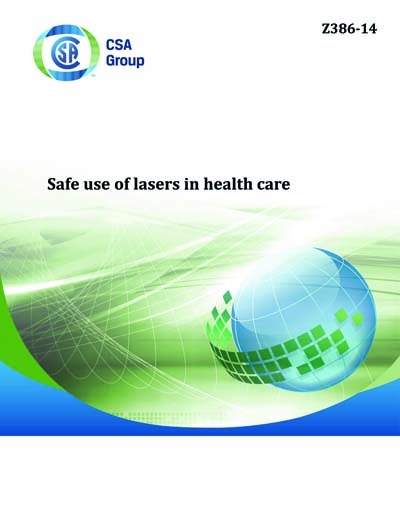Historical
CSA Z386-2014
Z386-14 - Safe use of lasers in health care
Preface
This is the fourth edition of CSA Z386, Safe use of lasers in health care. It supersedes the previous editions, published in 2008 under the title Safe use of lasers in health care facilities and in 2001 and 1992 under the title Laser Safety in Health Care Facilities.Scope
1.1 This Standard provides guidance for the safe use of lasers in health care. It applies to all procedures in health care settings where health-related lasers are used, including, but not limited to, the following: a) health care facilities; b) dental clinics, offices, and facilities; c) veterinary facilities; d) laboratories and other research facilities; e) physician offices; f) cosmetic and aesthetic treatment facilities; g) medical teaching facilities; h) medical professional exhibitions and trade shows; and i) medical laser servicing organizations. 1.2 This Standard presents the engineering, procedural, and administrative controls necessary to ensure the safety of persons at risk in the vicinity of a health-related laser, based upon a risk assessment. Note: A risk assessment is a thorough look at the workplace to identify situations, processes, etc. that can cause harm. A risk assessment, performed before policies and procedures are developed, is useful for determining engineering, administrative, and procedural controls and work practices to reduce the risk of laser exposure through a) identification of hazards; b) analysis or evaluation of the risks associated with those hazards; and c) determining appropriate ways to eliminate or control the hazards. 1.3 The control measures described in this Standard do not preclude the use of laser systems, of any type, that can be intentionally administered for diagnostic, therapeutic, aesthetic, or research purposes. However, those persons administering and assisting in the administering of the laser systems, as well as the patient, where applicable, should be protected through the implementation of appropriate control measures and other provisions described in this Standard. 1.4 This Standard does not comment on the purposes, risks, or benefits of procedures or equipment, as they are the professional responsibility of health care providers. This Standard does, however, offer general guidelines to ensure the safe use of health-related lasers in health care settings as outlined in Clause 1.1. 1.5 In this Standard, shall is used to express a requirement, i.e., a provision that the user is obliged to satisfy in order to comply with the standard; should is used to express a recommendation or that which is advised but not required; and may is used to express an option or that which is permissible within the limits of the standard. Notes accompanying clauses do not include requirements or alternative requirements; the purpose of a note accompanying a clause is to separate from the text explanatory or informative material. Notes to tables and figures are considered part of the table or figure and may be written as requirements. Annexes are designated normative (mandatory) or informative (non-mandatory) to define their application.Content Provider
CSA America, Inc. [csa]






